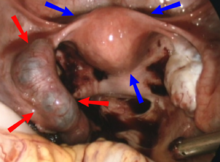Hämatosalpinx
| Klassifikation nach ICD-10 | |
|---|---|
| N83.6 | Hämatosalpinx |
| ICD-10 online (WHO-Version 2019) | |
Die Hämatosalpinx (von altgriechisch αἷμα haima, deutsch ‚Blut‘ und altgriechisch σαλπίγξ salpinx, deutsch ‚Eileiter‘) ist eine Ansammlung von Blut in einem oder in beiden Eileitern (lateinisch Tuba uterina).[1]

Ursache
Als Ursache kommen infrage:[2]
- Eileiterschwangerschaft
- Endometriose, die beiden häufigsten Ursachen
- Salpingitis und andere Entzündungen im Becken
- Tubentorsion (Verdrehung des Eileiters um die eigene Längsachse)
- Tubenkarzinom
- Trauma
- als Komplikation bei einem Hämatokolpos
Klinische Erscheinungen
Die klinischen Kriterien hängen von der Ursache ab, siehe jeweils dort.
Diagnose
Der erste und wegweisende diagnostische Schritt nach der klinischen Untersuchung ist die Sonografie. Häufig wird eine Laparoskopie notwendig sein.
Literatur
- M. Nacharaju, V. S. Vellanki, S. B. Gillellamudi, V. K. Kotha, A. Alluri: A rare case of chronic ectopic pregnancy presenting as large hematosalpinx. In: Clinical medicine insights. Reproductive health. Bd. 8, 2014, S. 1–4, doi:10.4137/CMRH.S13110, PMID 24812530, PMC 4007565 (freier Volltext).
- C. L. Diehl, L. P. Gavrilova-Jordan, C. C. Coddington: Acute abdominal pain as a result of a ruptured hematosalpinx: a rare complication of an unusual müllerian anomaly. In: Journal of pediatric and adolescent gynecology. Bd. 22, Nr. 3, Juni 2009, S. e9–11, doi:10.1016/j.jpag.2008.02.005, PMID 19539197.
- T. Römer, B. Bojahr, G. Schwesinger: Treatment of a torqued hematosalpinx in the thirteenth week of pregnancy using gasless laparoscopy. In: The Journal of the American Association of Gynecologic Laparoscopists. Bd. 9, Nr. 1, Februar 2002, S. 89–92, PMID 11821614.
Einzelnachweise
Weblinks
🔥 Top keywords: Wikipedia:HauptseiteSpezial:SucheRobert FicoSpecial:MyPage/toolserverhelferleinconfig.jsNeukaledonienListe der größten AuslegerbrückenPetr BystronMohammed Hassan (Bergträger)Joan CollinsZigeunerlager AuschwitzDamian HardungBridgertonNetiporn SanesangkhomHuhu-KäferChatGPTSlowakeiPfingstenYasukeMontius MagnusHauptseiteMaxton Hall – Die Welt zwischen unsEishockey-Weltmeisterschaft der Herren 202416. MaiNekrolog 2024Fußball-Europameisterschaft 2024Deine JulietWikipedia:Wiki Loves Earth 2024/DeutschlandDatei:Germany adm location map.svgDeutschlandMarinus van der LubbePornhubNatriumazidHarriet Herbig-MattenChristian KohlundBjörn HöckeTabunDavid Copperfield (Zauberkünstler)Nina ChubaRammstein